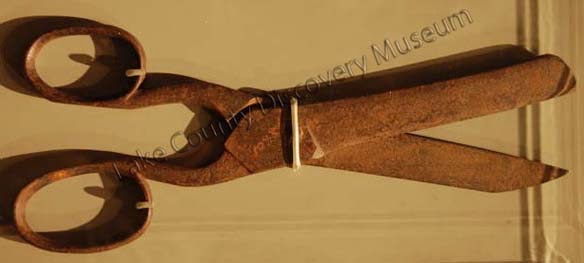 |
| Image of Mastodons courtesy of American Museum of Natural History |
The use of the term "mammoth" by the Gazette may have been simply to signify something quite large, but it should be noted that although similar in appearance, mastodons and mammoths are two distinct species. The most important difference was how they ate. Both were herbivores, but mastodons had cone-shaped cusps on their molars to crush leaves, twigs, and branches. Mammoths had ridged molars that allowed them to cut through vegetation and graze.
Mastodons began to disappear from
The most exciting discovery of a mastodon occurred in the summer of 1925. While dredging a canal on his property in Ingleside, Herman Kaping (1870-1932) brought up the ribs and bones of a mastodon. The skull was also found and hoisted several times, but each time slipped off the dredge's bucket back into the water.
The discovery caught the interest of scientists when Kaping sent the 56" rib bone and 10" long vertebra to the Field Museum of Chicago for identification. He later gifted the bones to the Field Museum. Soon the Field Museum's associate curator of paleontology, Professor Elmer S. Riggs (1869-1963), and associate curator of geology, Dr. H.W. Nichols, arrived to search for more bones.
 |
| Herman Kaping's resort, Ingleside, circa 1912, near the site of mastodon bones discovery. Dunn Museum M-86.1.361 |
 |
| Herman Kaping (left) and Prof. Riggs of the Field Museum of Chicago at the site of the Mastodon find in Ingleside. Chicago Tribune, July 29, 1925. |
Riggs and Nichols were unable to recover more bones, but Riggs gave an impromptu talk on the size and habits of the mastodon to a crowd of onlookers.
On March 11, 1962, another attempt was made to recover the mastodon skull at Kaping's. The site had come to be known as "Mastodon Isle" for the 1925 find.
 |
| Examining a mastodon bone: Ken Bundy (diver), William Palmer, Harry Kaping, and Charles Dussman. News-Sun, March 13, 1962. |
 |
| Robert Vogel (center with paper) discusses the plan for finding more mastodon bones at Mastodon Isle. Property owner, Harry Kaping (right wearing fedora) March 11, 1962. Dunn Museum photo. |
 |
| Mastodon leg bone recovered in 1925 from Kaping's (above) was donated to Vogel's museum. It is on permanent exhibit at the Bess Bower Dunn Museum in Libertyville, IL. BBDM 91.0.597. |
 |
| Mastodon statue and prairie flowers representing Lake County's historic flora and fauna. Lake County Discovery Museum at Lakewood Forest Preserve, Wauconda. (2014) |
- Diana Dretske, Curator ddretske@LCFPD.org




























